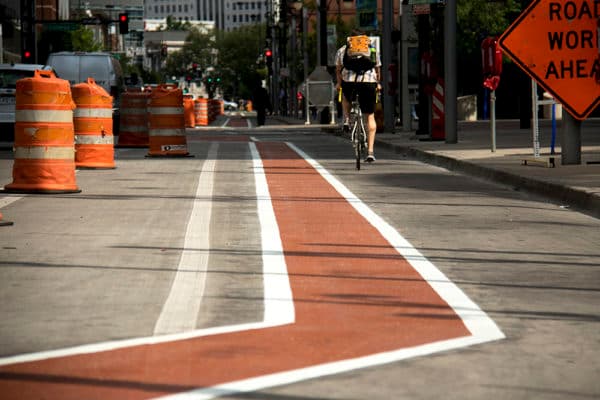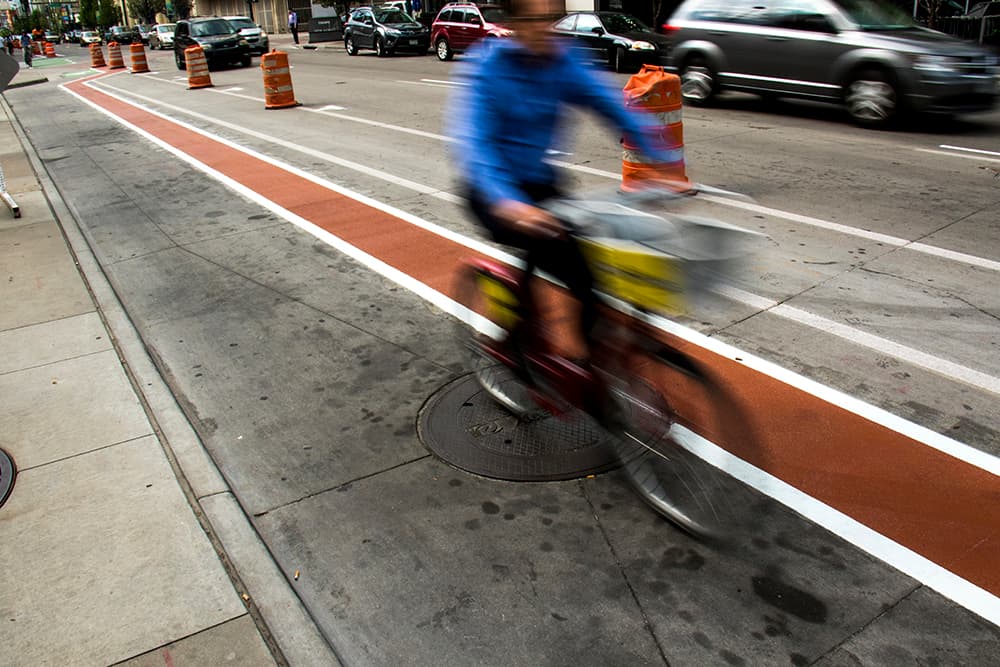
Bicycle Colorado Denver Director Piep van Heuven has been biking to work on a daily basis for about two years. In that time, she’s seen an increase in the kind of random things blocking bicycle lanes — a nuisance, but she usually takes a second to chat with the person responsible.
Generally speaking, van Heuven said the person’s reaction falls into one of three categories.
One third have no idea they’re blocking a bike lane, while another third are aware and are immediately apologetic. The last third know they’re blocking a lane and don’t really care.
“About a third of people do not know they’re in a bike lane and are either from out of town or have not been introduced to them,” van Heuven said. “They’ll thank me, they’ll have a nice conversation.”
It'll soon be easier to educate people on bike lane usage. On Monday, Bicycle Colorado and BikeDenver announced they're partnering to launch the appropriately named Things in the Bike Lane campaign. The crowdsourcing effort encourages everyone on two wheels, four wheels or no wheels to documents instances of bike lanes being blocked or otherwise impeded, which van Heuven said can cause safety concerns for cyclists.
People can post a photo of the bike lane obstruction with the location and other information to thingsinbikelanesdenver.com, which has already logged several instances since its recent soft launch (some ‘things’ so far reported on bike lanes: UPS trucks, a ride-sharing vehicle, utility trucks, a ... Segway tour?). Their goal is to help catalog when this happens and find trends and determine certain “hotspots” in the city. The data gathered would then be sent to Denver Public Works for their benefit.
“It’s going to capture that pinpoint data that we need,” van Heuven said. “What we’re interested in getting is how people (are) using the bike lanes.”
The website is modeled after one in Boston.
James Waddell, executive director at BikeDenver, said Denver’s website was inspired by one in Boston, called carsinbikelanesboston.com. However, Denver’s website removed one feature available in the Boston site. The Massachusetts site allows users to submit a car’s plates (it even includes a mock-up plate, complete with each state’s unique plate design) when submitting a photo of the bike lane issue.
“You’re not going to gain anything from shaming folks,” Waddell said.
Thingsinbikelanesdenver.com is a more cohesive approach to something Waddell said many people already do on social media. When people see cars and other stuff blocking lanes, it can sometimes can lead to angry posts popping up on timelines.
“They get a little hysterical, but nothing comes from it,” Waddell said, adding that website will be a, “factual, kind of pictorial representation of what’s going on in those bike lanes,” completed in a, “non-hysterical manner.”
Waddell said he understands the city isn’t fully equipped to patrol every bike lane, which is why the website could prove so beneficial. Once a large enough data set is gathered, they will be able to provide the information to Public Works to point out the problem areas.
The campaign will be active through the end of the year, though van Heuven said they may consider making the website a permanent fixture. A preliminary report will be sent to Denver Public Works in April ahead of their budget process.
“We’re hoping that this will be widely used by the public to have just the broadest possible data set,” van Heuven said said.
Allison Redmon, a spokesperson for Denver Public Works, said in an email that DPW was briefed on the initiative prior to its launch.
“We are looking forward to seeing the data collected to help us understand what blocks or areas of the city should be considered for additional enforcement attention or other mitigation strategies to keep access to the bicycle travel lane open and safe for everyone,” Redmon said over email.
Local law sets the rules for Denver's bike lanes.
City law defines a bicycle lane pretty plainly: “Bicycle lane shall mean a lane on a roadway reserved for the exclusive use of bicycles.” The law also defines bicycles as vehicles propelled by human power through pedals that have two wheels in tandem or two parallels wheels and one forward wheel. Those wheels have to be more than 14 inches in diameter.
Redmon said bike lanes are considered a travel lane in the city's revised municipal code, which means Denver Police can cite vehicles parked in the bike lane.
"Currently in the downtown area our enforcement agents are on a block about twice an hour, but sometimes it is difficult for our agents to issue citations, as vehicles are only blocking the bike lane for a short amount of time. If you see a vehicle parked in the bike lane, you can report it to our dispatch at 720-913-1600," Redmon said over email.
Anecdotally, van Heuven said most people will say it's cars that are most often seen blocking these lanes.
“We’re making no assumptions ... at the end of the day, I think what the public needs to know, by definition, by law, is a line on the roadway that is reserved exclusively for bicycles," van Heuven said.
The campaign also wants people to document other safety concerns, like “salmon” bicyclists, who are riders going the wrong way in a bike lane (van Heuven said likened this to drivers moving the wrong way on a road).
Redmon said the city has about 196 miles of on-street bikeways in Denver, which includes 9 miles of protected and buffered bike lanes.
"Denver invests approximately $2.2M in bike infrastructure each year. Our goal in 2018 is to upgrade and/or construct 25 miles of bikeways," Redmon said over email.
How you can document things in the bike lane
You can visit thingsinbikelanesdenver.com and report things blocking bike lanes on basically any device with internet access. Though it doesn't require it, adding a photo is encouraged when making a submission. Van Heuven said a post will generally appear on the website within 24 hours of posting.
Each post will have a date and the type of thing in the bike lane, with optional information like cross street and additional info.













